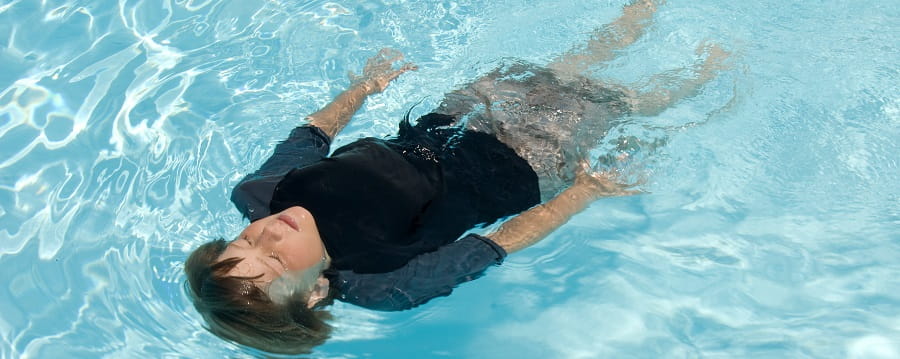
Survival Backstroke is effective in both rescue and survival situations. It is a great stroke for maintaining energy levels as it can be done as slowly as necessary. Survival backstroke is also useful for towing, especially when two hands are required to hold a person in difficulty. The main disadvantage of the stroke is the swimmer has no view in the direction of travel.
The basics of any stroke can be broken down into Body position, Legs, Arms, Breathing (BLAB). Survival Backstroke is no different and it is important to work through this in order e.g. it is very difficult to work on breathing if your student has an incorrect body position.
Body Position
The body position for Survival Backstroke is streamlined on the back with both ears in the water. The hips are kept close to, but slightly below the water.
Leg Action
The leg action is the inverted whip kick. It’s made up of three segments: the recovery, the kick and the glide.
- The Recovery: From the extended position of the glide, the legs bend at the knees and drop to assume a vertical position with the feet dorsi-flexed and averted. The knees are slightly parted, no wider than the swimmer’s shoulders.
- The Kick: The feet are swept in an accelerating circular motion, outwards, backwards and upwards, ending with the feet together, plantar flexed in the glide position. The movement is symmetrical and simultaneous.
- The Glide: The swimmer maintains the streamlined glide position until the momentum of the body decreases. The leg action is then repeated.
Arm Action
The arm action, like the leg action is also symmetrical and simultaneous. The propulsive phases of both arms and legs commence at the same time.
From the extended arm position at the side of the body in the glide, the arms bend at the wrist and elbow to allow the hands to move to shoulder level while remaining very close to the body (run the thumbs along the side of the body). It is important to keep the hands and arms close to the sides of the body to enhance streamlining. When the hands reach shoulder level, they extend beyond the shoulders, elbows bent, with hands facing away from the body and towards the feet.
From this position at the end of recovery the arms follow a curved pathway until hands and arms reach the glide position.
Breathing Action
The breathing action in Survival Backstroke is natural. Usually exhalation occurs with propulsion.
Progressions for Teaching
It is important to introduce new strokes using progressions to allow students to attempt smaller parts of the stroke and grasp skills before moving on. Suggested progressions for Survival Backstroke include:
- Foot exercises – sitting with legs extended, point toes down and turn feet out repeatedly.
- Backward glide and recover – from a gliding position (shoulders under, head back) ensure horizontal body position, head submerged to the crown and chin slightly tucked in before recovering to a standing position.
- Leg action on back (with board or sculling) – progress with different combinations of skills using the leg action e.g. glide – single kick – glide – stand up, single kick with extended glide, continuous kicks etc.
- Arm action – ensuring arms recovering close to the body, palms pointing outward (at shoulder level) and hands pushing out and down to thighs.
- Whole stoke – from a glide, arms start recovery just before legs, arms and legs start push together, significant glide phase.
- Refine the stroke – continue refining the individual components of the stroke.